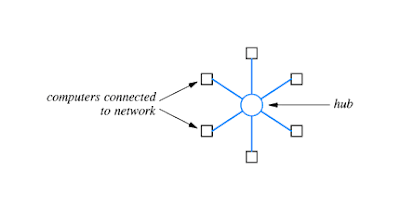LAN Topologies used frequently in most sites are classified into three topologies : star topology, ring topology, and bus topology.
Star topology :  A network uses a star topology if all computers attach to a central point.
A network uses a star topology if all computers attach to a central point.
Because a star-shaped network resembles the spokes of a wheel, the center of a star network is often called a hub. A typical hub consists of an electronic device that accepts data from a sending computer and delivers it to the appropriate destination.
In practice, star networks seldom have a symmetric shape in which the hub is located an equal distance from all computers. Instead, a hub often resides in a location separate from the computers attached to it.
Ring Topology : A network that uses a ring topology arranges for computers to be connected in a closed loop. The name ring arises because one can imagine the computers and the cables connecting them arranged in a circle.
A network that uses a ring topology arranges for computers to be connected in a closed loop. The name ring arises because one can imagine the computers and the cables connecting them arranged in a circle.
It is important to understand that the ring, like the star topology, refers to logical connections among computers, not physical orientation – the computers and connections in a ring network need not be arranged in a circle. Instead, the cable between a pair of computers in a ring network may follow a hallway or rise vertically from one floor of a building to another.
Bus Topology : A network that uses a bus topology usually consists of a single, long cable to which computers attach. Any computer attached to a bus can send a signal down the cable, and all computers receive the signal. Because all computers attached to the cable can sense an electrical signal, any computer can send data to any other computer. Of course, the computers attached to a bus network must coordinate to ensure that only one computer sends a signal at any time or chaos results.
A network that uses a bus topology usually consists of a single, long cable to which computers attach. Any computer attached to a bus can send a signal down the cable, and all computers receive the signal. Because all computers attached to the cable can sense an electrical signal, any computer can send data to any other computer. Of course, the computers attached to a bus network must coordinate to ensure that only one computer sends a signal at any time or chaos results.
Reference :
“Computer networks and Internets with Internet Applications (Third Edition), Douglas E. Comer, Prentice Hall”
Jan 28, 2008
LAN Topologies
Posted by แชมป์ (champ) at 21:21
Subscribe to:
Post Comments (Atom)

No comments:
Post a Comment